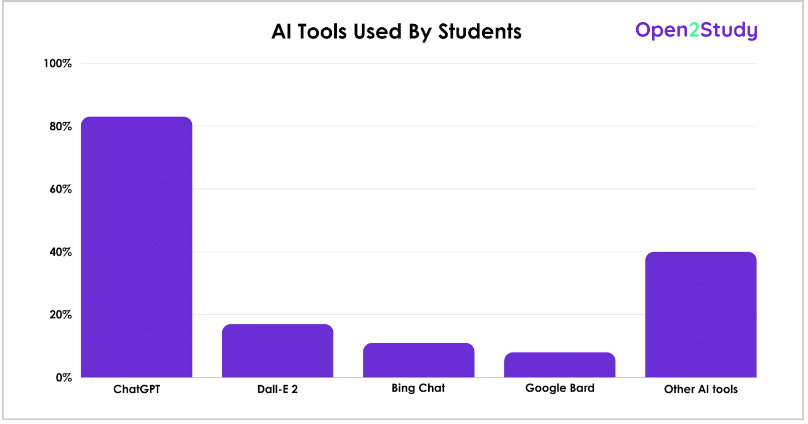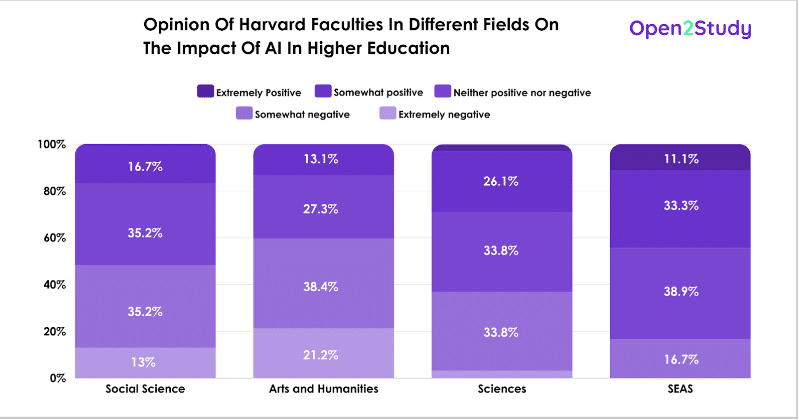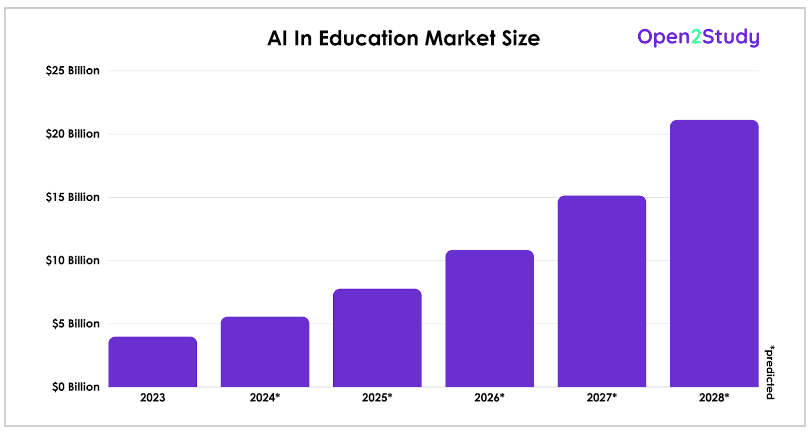60% of administrators claim to use AI in their institutions, highlighting the increase of AI in education.
Further, 97% of the students are more likely to take courses that involve AR and VR, and over 9 in 10 educators agreed that AR and VR can boost students’ engagement in education.
Let’s take a detailed look at the latest statistics about AI in education, students’ usage of AI, teachers’ usage of AI in education, how AI has impacted the educational landscape, and the future of AI in education.
Top AI In Education Statistics 2025
- 56% of college students utilize AI to complete their assignments.
- 65% of the teachers already use AI for academic work.
- In fall 2023, 49% of the students used AI writing tools.
- 6 in 10 educators use AI in classrooms.
- 95% of the students reported that their grades improved after studying with ChatGPT.
- The AI in the education market is estimated to reach $5.57 billion in 2024.
Student Use Of AI In Education
46% of the students in grades 10 to 12 use AI tools for academic and non-academic activities.
Nearly half of the students who accepted using AI said they used it for homework. However, 64% of the students used it a few times a month or less for school assignments.
Another 28% of the students stated that they used AI tools once or a few times a week for their school homework and assignments. Meanwhile, 8% of the students reported using AI once a day or more.
Source: ACT
54% of the students reported not using AI for academics or other work.
Out of these students, the majority were not interested in using AI, while 64% said they did not trust the information provided by the AI tools.
On the other hand, over 2 in 10 students who did not use AI said they were not allowed to use AI.
The following table displays why 54% of students did not use AI.
| Reason For Not Using AI | Percentage Of Students |
|---|---|
| Not interested in Using AI | 83 |
| Do not trust information | 64 |
| Do not know enough about AI | 55 |
| Other reason | 25 |
| Not allowed to use | 23 |
| Do not have access | 15 |
Source: ACT
83% of the students who use AI for their academic or nonacademic work stated that they used ChatGPT. If you also want to know how you can use ChatGPT for studies, then check our guide on ChatGPT for students.
Meanwhile, 17% of the students using AI reported using Bing Chat, and 8% used Google Bard/ Gemini.
At the same time, 40% of the students stated that they used other AI tools like Grammarly, Midjourney, etc.
The following table displays the AI tools that are most used by students.

| AI Tools | Percentage of AI-Using Students Using The Tool |
|---|---|
| ChatGPT | 83% |
| Dall-E 2 | 17% |
| Bing Chat | 11% |
| Google Bard | 8% |
| Other AI tools like Midjourney, Grammarly, etc. | 40% |
Source: ACT
56% of college students stated using AI in exams or assignments.
Meanwhile, 53% of the students stated that they had coursework that required AI to be used as a part of assignments.
On the other hand, 79% of the students stated that at least one of their instructors discussed the ethics of AI usage in their classroom.
Source: Best Colleges
54% of college students believe that using AI tools to complete assignments or in exams is cheating or plagiarism.
On the other hand, 21% of the students believe using AI tools for completing assignments or plagiarism is not cheating.
Meanwhile, 25% of college students do not have any view on this.
Source: Best Colleges
62% of the students in Business majors have used AI.
AI tools are most commonly used by students pursuing majors like Business, STEM, and Humanities.
Over 6 in 10 business major students stated that they use AI for academic and non-academic purposes. Additionally, 59% of the students in STEM majors and 52% of humanity majors stated that they have used AI.
Source: Best Colleges
62% of Millennial students have used AI tools for academic work.
Comparatively, only 52% of GenZ students reported using AI tools to complete their academic work.
65% of the Millennials and 46% of GenZ reported that they had to use AI tools as a part of their coursework.
Despite higher usage of AI tools among Millenials, 56% of Millennials believe that it is cheating to use AI tools for assignments and in exams. Comparatively, 53% of the GenZ believe the same.
Source: Best Colleges
Nearly 1 in 2 college students in the United States used AI writing tools in the fall of 2023.
The adoption rate of generative AI has been higher among students since the beginning. Only 27% of students used AI writing tools in spring 2023. Comparatively, 49% of the students used AI writing tools in fall 2023.
The top usage of AI was summarizing or paraphrasing texts, answering their homework questions, and organizing their schedule.
Source: Inside Higher Ed.
Teachers Using AI In Education
6 in 10 educators reported that they use AI in the classroom.
AI tools have gained popularity in academics. Younger teachers under 26 years are likelier to use AI in their classrooms.
51% of the teachers have used AI-powered educational games in their classrooms, while 43% stated that they used adaptive learning platforms in their classrooms.
The following table displays further details about the AI tools or applications teachers use in the classroom.
| AI-Based Tools Or Applications | Percentage Of Teachers |
|---|---|
| AI-powered educational games | 51% |
| Adaptive learning platforms | 43% |
| Automated grading and feedback systems | 41% |
| Chatbots for student support | 35% |
| Intelligent tutoring systems | 29% |
| Other (please specify) | 5% |
| No AI-based tools in particular | 6% |
| Not sure | 3% |
Source: Forbes.
65% of the teachers use AI technologies for academic work.
Nearly half of the teachers stated that they were excited and optimistic about the adoption of AI in education.
Further, 44% of the teachers stated that they used AI for research purposes, while 38% of the teachers stated that they used AI to generate lesson plans.
The following table highlights the reasons teachers use AI in education.
| Reason To Use AI In Education | Percentage Of Teachers |
|---|---|
| For Research | 44% |
| Generating lesson plans | 38% |
| Summarizing or synthesizing information | 38% |
| Generating classroom materials like tests and assignments | 37% |
Source: PR Newswire.
Over 75% of the faculty members reported that they do not regularly use AI.
A study conducted by Turnitin among 1,000 faculty members and 1,600 students across more than 600 institutions in September 2023 revealed that over one-third of the faculty members do not use AI regularly.
Most of these faculties reported using Generative AI tools to check what students see. Besides, over one-third of the faculties use Gen AI to train their students about the effective usage of AI.
According to the survey, here are further details about how the faculties used Gen AI writing tools.
- Running prompts in the AI tools to find what students see: 43%
- Training students on how to effectively use AI tools: 35%
- To create engaging in-class activities29%
- Generating writing assignments 26%
- Writing syllabi: 21%
- Generating rubrics for grading student work: 20%
- Generating quizzes and assessments: 19%
- Adapting texts to different reading levels: 16%
- Generating answers to the student queries: 14%
- Getting assistance in student work: 10%
- Analysis of peer grading exercises: 6%
Source: Turnitin
55% of teachers believe that AI has positively affected the education system.
Over half of the teachers who participated in the Forbes survey believed that AI has improved the teaching and learning process.
On the other hand, nearly 2 in 10 teachers believe that AI has negatively impacted educational outcomes.
Here are further details about teachers’ opinions on the influence of AI on the teaching and learning process in the classrooms.
| Impact Of AI In Education | Percentage Of Teachers |
|---|---|
| Improved educational outcomes | 55% |
| Negatively impacted the educational outcomes | 18% |
| AI has not significantly impacted the teaching and learning process in their classroom | 17% |
| Not sure about AI’s impact on educational outcomes | 10% |
Source: Forbes.
Nearly two-thirds of educators are concerned about plagiarism in essays and other educational work due to the usage of AI.
The majority of educators are concerned about the increased adoption of AI in education. With the increased usage of AI in classrooms, academic dishonesty is teachers’ top concern for their students.
65% of the teachers worry about the plagiarism they find at work, while nearly 3 in 5 teachers worry about the students’ reduced interaction in the learning environment.
Additionally, 3 in 10 teachers are concerned that AI will take their jobs.
The following table displays teachers’ top concerns with adopting AI in education.
| Concerns Educators Have Regarding The Adoption Of AI In Education | Percentage Of Educators |
|---|---|
| Increased plagiarism in essays and other writing works | 65% |
| Reduced human interaction in the learning process | 62% |
| Data Privacy and security | 42% |
| Displaced of educator’s jobs | 30% |
| Unequal access to AI resources | 30% |
| Automation of manual tasks | 23% |
| No concerns in particular | 4% |
| Other concerns | 1% |
| Not sure about the concerns | 1% |
Source: Forbes
Impact Of AI In Education
The dropout rates in some colleges can be reduced by 10% to 15% with the adoption of AI.
Students dropping out is one of the main hurdles for higher education worldwide. However, using machine learning to understand the engagement rate of the students in education and the patterns of student engagement can reduce the dropout rates.
These AI technologies are currently in use in Wisconsin (United States), Buenos Aires Province (Argentina), and Victoria (Australia) to assist in the development of early detection models for school dropout risks.
Source: Zipdo, Development Bank of Latin America and the Caribbean.
95% of the students using ChatGPT reported that their grades improved after studying with ChatGPT.
A survey of 3000 high school and college students brought into the limelight that 90% of the students prefer to study with the help of ChatGPT. Of these, 95% of the students believed that their grades improved after studying with the assistance of ChatGPT.
Generative AI, like ChatGPT, has the potential to offer personalized study instructions and help students with special needs. Some of the applications of generative AI while studying are AI summarizing the textbook material in bullet points, charts, and images to assist students with attention deficit disorder or dyslexia.
Source: The Week.
47% of the Harvard faculties believe that AI adoption will negatively impact higher education.
In the Crimson’s annual survey of the Faculty of Arts and Sciences conducted at Harvard, nearly half of the faculties stated their concern about the negative impact of AI in higher education.
Meanwhile, less than a quarter of respondents stated that AI will positively impact higher education. The Harvard faculties in STEM fields were less pessimistic about AI’s effect than those in humanities and social sciences.
Here are further details about the views of Harvard faculties in different fields on the Impact of AI in higher education:

| Opinion of Harvard Faculties | Social Science | Arts and Humanities | Sciences | SEAS |
|---|---|---|---|---|
| Extremely negative | 13% | 21.2% | 3.1% | – |
| Somewhat negative | 35.2% | 38.4% | 33.8% | 16.7% |
| Neither positive nor negative | 35.2% | 27.3% | 33.8% | 38.9% |
| Somewhat positive | 16.7% | 13.1% | 26.1% | 33.3% |
| Extremely Positive | – | – | 3.1% | 11.1% |
Source: The Harvard Crimson.
AI In The Education Market
AI in the education market size is estimated to reach $5.57 billion in 2024.
AI in the education market was valued at $3.99 billion in 2023 and is forecasted to reach $5.57 billion in 2024, growing at a CAGR of 39.7%.
The AI in education market is further expected to reach $21.13 billion in 2028, growing at a compound annual growth rate of 39.6% between 2024 and 2028.
The significant factors that fuel the growth of AI in the education market are the widespread adoption of digital learning platforms, the implementation of adaptive learning and personalized learning systems, and the integration of AI in tutoring.
The following table displays the AI in education market size over the years.

| Year | AI In The Education Market Size |
|---|---|
| 2023 | $3.99 billion |
| 2024* | $5.57 billion |
| 2025* | $7.77 billion |
| 2026* | $10.84 billion |
| 2027* | $15.14 billion |
| 2028* | $21.13 billion |
*-projected values
Source: Research and Markets.
Generative AI could bring $200 billion in value to the global education sector by the year 2025.
According to an analyst in Morgan Stanley’s sustainability research team, generative AI has the ability to enhance the overall learning experience.
The analyst further states that the gen AI technology will play a significant role in cutting down administrative work, maximizing human interaction, and upskilling or reskilling the workers in the educational fields affected by technology.
As a result, generative AI efficiencies could add $200 billion to the global education sector by the end of the year 2025.
Source: Morgan Stanley.
Future Of AI In Education
47% of the learning management tools will run on AI by 2025.
The learning management tools that empower learning and development to help staff and teams improve at tedious administrative tasks will be AI-powered by 2025.
Incorporating AI in the LMS platforms comes with benefits like personalized learning experiences, data-driven insights into employee performance and learning patterns, and efficient management of training modules.
Source: Training Industry.
51% of the teachers believe that technology will have a positive impact in the future for teachers.
Over half of the teachers are optimistic about the impact of AI on the future of education for teachers.
Further, 49% of the teachers said AI has impacted their workload positively.
On the other hand, 21% of the teachers reported that these AI technologies will not have a positive or negative impact in the future.
Source: PR Newswire.
Nearly 9 in 10 academic leaders believe AI will lead to inevitable changes in higher education.
With the adoption of AI, the delivery model in higher education is changing rapidly. 89% of academic leaders believe that AI and digital technology are set to bring irreversible changes in teaching methods.
Source: Zipdo.
Conclusion
The above statistics prove that AI will surely revolutionize the education landscape in the upcoming years. From AI-powered tutors to adaptive learning powered by AI, AR and VR can personalize the student’s learning experience, making it fun and easier to understand the concepts.
Moreover, half of educators worldwide are optimistic about AI usage if the technology is used within the terms and conditions of educational institutes.
Hence, it will be fascinating to see how AI changes the education landscape by implementing generative AI, machine learning, deep learning, AR, VR, and more in the upcoming decade.
FAQs
56% of college students have used AI to complete assignments or exams. On the other hand, 26% of K-12 teachers have caught students cheating with AI.
A survey of fourteen AI detectors discovered that the accuracy of these AI tools may range between 33% and 81%, depending on the tool and prompts used.
AI cannot replace teachers in education. Teachers can adapt their approach according to students and provide detailed explanations where required. However, AI can help teachers with certain tasks like lesson planning and more.
40% of the students worldwide use AI. Of these, only 47% of the students are concerned that they may receive the wrong information. Most students said they use AI mainly for writing tasks and rarely for STEM work.
Article By

